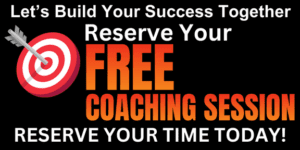As a business coach, I’ve had countless face-to-face meetings with prospects, and I know just how crucial these interactions are for closing deals, building trust, and creating long-term relationships.
A successful meeting doesn’t happen by chance—it requires planning, strategy, and execution. In this blog, I’ll share six proven tips for making the most of your in-person meetings so you can leave a lasting impression and increase your closing rates.
Preparing for In-Person Meetings
Preparation is the foundation of any successful prospect meeting. What you do before the meeting often determines whether you win the client or lose the opportunity.
1. Do Your Research
Walking into a meeting without researching your prospect is one of the most common—and avoidable—mistakes. Knowing who your prospect is, what their company does, and the challenges they face will help you personalize your approach and demonstrate value.
How to Research Effectively:
- Study Their Website: Review their mission statement, services, and recent news updates to understand their business priorities.
- Check LinkedIn: Learn about the person you’re meeting—what’s their role, background, and professional interests?
- Look for Press and Media Mentions: Find out if their business has been featured in the news or won any awards.
- Analyze Competitors: Know who their competitors are and identify areas where your solution can give them an edge.
Example: If you’re meeting with a construction company owner, research their recent projects, awards, or expansions. Reference this information in your pitch to show you’re invested in their success.
2. Set Clear Objectives
Every successful meeting starts with a clear objective. Whether your goal is to close a sale, gather information, or schedule a follow-up meeting, define it in advance to stay focused and steer the conversation effectively.
How to Set Objectives:
- Define Outcomes: What specific result do you want from the meeting? A signed contract? An agreement for another call?
- Prepare Questions: Write down 3–5 questions to help guide the conversation toward your goals.
- Anticipate Objections: Think about concerns your prospect might raise and plan responses in advance.
Example: If your goal is to schedule a follow-up meeting, end the conversation with: “Based on our discussion today, I’d love to show you how we can customize this solution for your team. Would next Thursday work for a follow-up?”
3. Prepare Your Pitch
A tailored pitch can make or break a face-to-face meeting. Instead of focusing on features, emphasize how your solution solves the prospect’s problems or helps them achieve their goals.
How to Structure Your Pitch:
- Start with Their Problem: Highlight a key challenge they’re facing.
- Introduce Your Solution: Show how your product or service directly addresses their needs.
- Demonstrate Value: Use case studies, success stories, or data to back up your claims.
- Focus on Results: Quantify the impact—will they save time, reduce costs, or increase revenue?
Example: Instead of saying “We provide CRM solutions,” you could say: “Businesses using our CRM tools have seen a 35% increase in lead conversion rates within six months.”
Closing Deals Face-to-Face
Once you’ve laid the groundwork, it’s time to connect, build trust, and close the deal during the meeting.
4. Build Rapport
Building rapport is about creating a genuine connection that makes your prospect feel comfortable and understood. People buy from those they trust, so taking time to build that foundation is critical.
Ways to Build Rapport:
- Start with Small Talk: Ask about their day, hobbies, or recent business developments to break the ice.
- Find Common Ground: Look for shared interests or experiences to build connections.
- Use Positive Body Language: Smile, make eye contact, and show enthusiasm.
- Mirror Their Style: Match their tone and pace to make the conversation feel natural.
Example: If the prospect mentions attending a conference you’re familiar with, ask about their experience there and share your own insights.
5. Listen and Ask Questions
Listening is just as important as presenting. Active listening shows you’re interested, builds trust, and uncovers insights that can help you tailor your offer.
How to Listen Effectively:
- Ask Open-Ended Questions: Encourage the prospect to share more details about their needs.
- Take Notes: Record key points to show you’re paying attention and to follow up later.
- Clarify Points: Repeat what they’ve said to confirm your understanding.
Example: Instead of asking “Do you need marketing help?” ask “What challenges are you facing with your current marketing strategy?”
6. Have a Strong Call to Action
The meeting should end with a clear next step. Be confident but not pushy—leave prospects feeling excited to move forward.
Examples of Strong CTAs:
- “Let’s schedule a follow-up meeting next week to finalize the proposal.”
- “I’ll send you a detailed outline of how we can implement this strategy by Friday. Does that work for you?”
- “Would you like me to put together a contract so we can get started?”
How to Handle Objections During Meetings
Handling objections during meetings is a critical skill that can determine whether you close the deal or lose the prospect. Objections aren’t always rejections—in many cases, they’re opportunities to clarify concerns, build trust, and demonstrate value. Here’s how to address objections effectively during face-to-face meetings and keep the conversation moving toward a successful outcome.
1. Stay Calm and Confident
Objections can sometimes catch you off guard, but it’s important to stay composed and confident. Prospects want to see how you handle pressure, and maintaining a professional demeanor can instill trust and credibility.
Tips:
- Pause for a moment to process the objection before responding. This shows you’re thoughtful rather than defensive.
- Maintain positive **body language**—make eye contact, nod, and smile to convey openness and professionalism.
- Take notes if needed to show you’re actively listening and treating their concerns seriously.
Example: If a prospect says, “Your price seems too high,” avoid reacting defensively. Instead, pause and say, “I understand budget is a concern. Let’s discuss the value this solution provides and how it aligns with your goals.”
2. Listen Carefully and Acknowledge the Objection
Often, prospects want to feel heard and understood before they’re willing to move forward. Avoid interrupting them, and give them space to express their concerns.
How to Listen and Acknowledge:
- Repeat or rephrase the objection to show you understand. *“So what I’m hearing is that you’re concerned about the timeline for implementation. Is that correct?”*
- Thank them for sharing their concerns. *“I appreciate you bringing that up. It’s important that we address this to ensure it’s a good fit.”*
- Ask clarifying questions to get to the root cause of the objection. *“Can you elaborate on what specific outcomes you’re looking for within that timeframe?”*
3. Reframe the Objection as an Opportunity
View objections as opportunities to provide more information and reinforce the value of your offer. Sometimes objections indicate the prospect is interested but needs more clarity or reassurance before making a decision.
How to Reframe Objections:
- Turn cost objections into value discussions: *“While the upfront investment may seem higher, let’s look at the long-term savings and increased revenue potential this solution offers.”*
- Address doubts with proof: Share **testimonials**, **case studies**, or **data** that validate your claims.
- Show flexibility: Offer payment plans or phased implementation to ease concerns about cost or timing.
Example: If a prospect says, “I’m not sure this will work for my industry,” respond with: “I completely understand your concern. Many of my clients felt the same way at first, but after implementing this strategy, they saw measurable improvements. Let me share one specific example with you.”
4. Ask Questions to Understand the Root Cause
Sometimes objections are surface-level, and you’ll need to dig deeper to uncover the real concern. Asking the right questions can help you address the issue effectively.
Questions to Ask:
- “What specifically about the price concerns you?” (Cost)
- “Is there anything about the product or service that feels unclear?” (Features/Benefits)
- “What factors are most important to you when making this decision?” (Priorities)
- “How do you see this fitting into your business’s current goals?” (Alignment)
Example: If a prospect says, “I don’t think this is the right time,” respond with: “What would make it the right time for you? Are there specific challenges you’re currently prioritizing?”
5. Provide Solutions, Not Excuses
Once you’ve identified the root cause of the objection, focus on offering solutions rather than making excuses. Show the prospect how your product or service can solve their problem.
How to Provide Solutions:
- Emphasize **ROI (Return on Investment):** Highlight how your offer saves money, boosts revenue, or improves efficiency.
- Offer **customization options:** Show flexibility by tailoring your solution to meet their specific needs.
- Provide **social proof:** Share success stories, testimonials, or client case studies to build credibility.
Example: If a prospect is worried about onboarding, respond with: “We have a step-by-step onboarding process with dedicated support, and many of our clients report a smooth transition. I’d be happy to show you a sample timeline.”
6. Confirm and Move Forward
After addressing objections, check in with the prospect to ensure they’re comfortable and ready to move forward.
How to Confirm and Close:
- Summarize the key points discussed and how their concerns were addressed.
- Ask for feedback: *“Does that resolve your concern about implementation?”*
- Offer next steps: *“I’ll follow up with a proposal outlining the customized plan we discussed. Can we schedule a time next week to review it?”*
Example: If a prospect says, “That makes sense now, but I’d like to think about it,” respond with: “I completely understand. How about I follow up with you early next week to address any further questions?”
Ready to Master Objection Handling?
Objections are not roadblocks—they’re opportunities to clarify concerns, build trust, and demonstrate your value. With preparation, confidence, and a focus on solutions, you can turn objections into agreements and win more deals.
Ready to Master Your Next Prospect Meeting?
Face-to-face meetings are powerful opportunities to build trust, showcase value, and close deals. By preparing thoroughly, tailoring your pitch, and focusing on relationship-building, you can turn prospects into long-term clients.
If you’re looking for personalized strategies to improve your meetings and boost conversion rates, I invite you to schedule a complimentary 1/2 hour coaching session.
Schedule your session today and take your prospect meetings to the next level!




